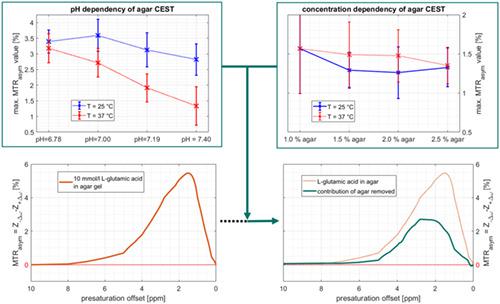当前位置:
X-MOL 学术
›
NMR Biomed.
›
论文详情
Our official English website, www.x-mol.net, welcomes your
feedback! (Note: you will need to create a separate account there.)
On the interference from agar in chemical exchange saturation transfer MRI parameter optimization in model solutions.
NMR in Biomedicine ( IF 2.7 ) Pub Date : 2020-09-15 , DOI: 10.1002/nbm.4403 Sebastian Mueller 1 , Klaus Scheffler 1, 2 , Moritz Zaiss 1, 3
NMR in Biomedicine ( IF 2.7 ) Pub Date : 2020-09-15 , DOI: 10.1002/nbm.4403 Sebastian Mueller 1 , Klaus Scheffler 1, 2 , Moritz Zaiss 1, 3
Affiliation

|
Chemical exchange saturation transfer (CEST) MRI is currently set to become part of clinical routine as it enables indirect detection of low concentrated molecules and proteins. Recently, intermediate to fast exchanging functional groups of glucose and its derivatives, glutamate and dextran, have gained attention as promising CEST contrast agents. To increase the specificity of CEST MRI for certain functional groups, the presaturation module is commonly optimized. At an early stage, this is performed in well‐defined model solutions, in which, for instance, the relaxation times are adjusted to mimic in vivo conditions. This often involves agar, assuming the substance would not yield significant CEST effects by itself, which the current study proves to be an invalid assumption. Model solutions at different pH values and concentrations of agar were investigated at different temperatures at a 9.4 T human whole body MR scanner. High power presaturation of around 4 μT, optimal for investigating intermediate to fast exchanging groups, was applied. Postprocessing included spatiotemporal corrections for B0 and spatial corrections for B1+. CEST effects of up to 3 % of the bulk water signal were observed. From pH, concentration and temperature dependency, it was concluded that the observed behavior reflects a CEST effect of agar. It was also shown how to remove this undesirable contribution from CEST MRI data. It was concluded that if agar is involved in the CEST MRI parameter optimization process, its contribution to the observed effects has to be taken into account. CEST agent concentration must be sufficiently high to be able to neglect the contribution of agar, or a control sample at matched pH is necessary for correction. Experiments on pure agarose showed reduced CEST effects compared with agar but did not provide a neutral baseline either.
中文翻译:

模型溶液中琼脂对化学交换饱和转移 MRI 参数优化的干扰。
化学交换饱和转移 (CEST) MRI 目前已成为临床常规的一部分,因为它能够间接检测低浓度分子和蛋白质。最近,葡萄糖及其衍生物、谷氨酸和葡聚糖的中间到快速交换官能团作为有前途的 CEST 造影剂而受到关注。为了提高 CEST MRI 对某些功能组的特异性,通常优化预饱和模块。在早期阶段,这是在定义明确的模型解决方案中执行的,例如,在其中调整弛豫时间以模拟体内条件。这通常涉及琼脂,假设该物质本身不会产生显着的 CEST 效应,目前的研究证明这是一个无效的假设。在 9.4 T 人体全身 MR 扫描仪上在不同温度下研究了不同 pH 值和琼脂浓度的模型溶液。应用了大约 4 μT 的高功率预饱和,最适合研究中间到快速交换组。后处理包括 B 的时空校正0和 B 1 + 的空间校正。观察到高达 3% 的大量水信号的 CEST 效应。从 pH、浓度和温度依赖性得出结论,观察到的行为反映了琼脂的 CEST 效应。还展示了如何从 CEST MRI 数据中去除这种不良影响。得出的结论是,如果琼脂参与 CEST MRI 参数优化过程,则必须考虑其对观察到的影响的贡献。CEST 试剂浓度必须足够高才能忽略琼脂的影响,或者需要具有匹配 pH 值的对照样品进行校正。纯琼脂糖实验表明,与琼脂相比,CEST 效应降低,但也没有提供中性基线。
更新日期:2020-09-15
中文翻译:

模型溶液中琼脂对化学交换饱和转移 MRI 参数优化的干扰。
化学交换饱和转移 (CEST) MRI 目前已成为临床常规的一部分,因为它能够间接检测低浓度分子和蛋白质。最近,葡萄糖及其衍生物、谷氨酸和葡聚糖的中间到快速交换官能团作为有前途的 CEST 造影剂而受到关注。为了提高 CEST MRI 对某些功能组的特异性,通常优化预饱和模块。在早期阶段,这是在定义明确的模型解决方案中执行的,例如,在其中调整弛豫时间以模拟体内条件。这通常涉及琼脂,假设该物质本身不会产生显着的 CEST 效应,目前的研究证明这是一个无效的假设。在 9.4 T 人体全身 MR 扫描仪上在不同温度下研究了不同 pH 值和琼脂浓度的模型溶液。应用了大约 4 μT 的高功率预饱和,最适合研究中间到快速交换组。后处理包括 B 的时空校正0和 B 1 + 的空间校正。观察到高达 3% 的大量水信号的 CEST 效应。从 pH、浓度和温度依赖性得出结论,观察到的行为反映了琼脂的 CEST 效应。还展示了如何从 CEST MRI 数据中去除这种不良影响。得出的结论是,如果琼脂参与 CEST MRI 参数优化过程,则必须考虑其对观察到的影响的贡献。CEST 试剂浓度必须足够高才能忽略琼脂的影响,或者需要具有匹配 pH 值的对照样品进行校正。纯琼脂糖实验表明,与琼脂相比,CEST 效应降低,但也没有提供中性基线。









































 京公网安备 11010802027423号
京公网安备 11010802027423号